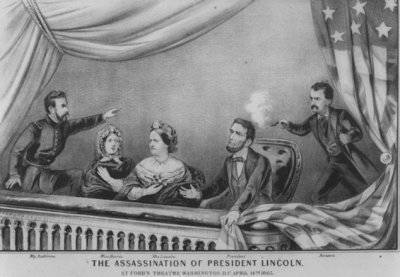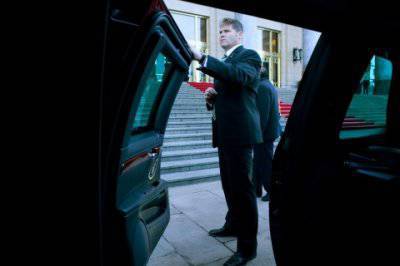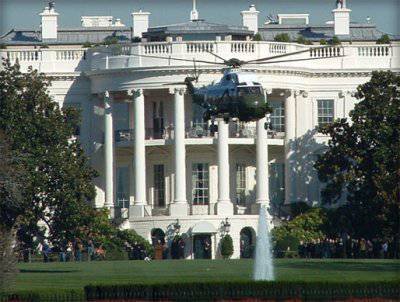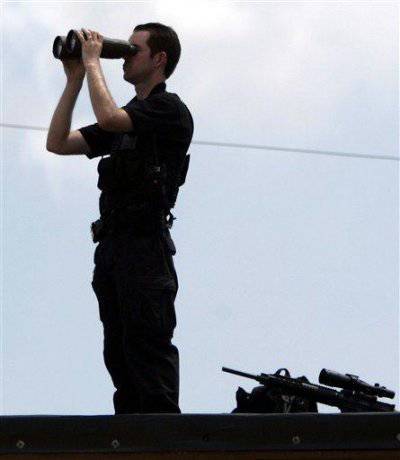History of the US Secret Service
 Contrary to one hackneyed phrase, far from everything becomes obvious. And certainly not immediately. Only in recent decades has information about one of the most mysterious state institutions, the US Secret Service, started to appear. Today it is hard to believe that the United States Secret Service (or USSS for short) was created as a structure that had to withstand the counterfeiters' rampant in the second half of the 19 of the 20th century. At the beginning of the 1860s, more than 1,500 US banks independently printed banknotes of various denominations, and the federal and local authorities had almost no control over them. Numerous criminal groups literally flooded the country with fakes that made up about a third of the money supply. This problem at the end of the Civil War threatened with financial collapse. Only after the reform in the 1863 year, the federal treasury began to deal with the issue of banknotes, which began issuing dollars according to a single standard. However, counterfeiters continued to go unpunished.
Contrary to one hackneyed phrase, far from everything becomes obvious. And certainly not immediately. Only in recent decades has information about one of the most mysterious state institutions, the US Secret Service, started to appear. Today it is hard to believe that the United States Secret Service (or USSS for short) was created as a structure that had to withstand the counterfeiters' rampant in the second half of the 19 of the 20th century. At the beginning of the 1860s, more than 1,500 US banks independently printed banknotes of various denominations, and the federal and local authorities had almost no control over them. Numerous criminal groups literally flooded the country with fakes that made up about a third of the money supply. This problem at the end of the Civil War threatened with financial collapse. Only after the reform in the 1863 year, the federal treasury began to deal with the issue of banknotes, which began issuing dollars according to a single standard. However, counterfeiters continued to go unpunished.The official date of creation of the USSS is considered to be 5 July 1865-th, then it was called the secret unit to combat counterfeiters. It is noteworthy that Hugh McCulloch, being at that time the US Treasury Secretary, came with a proposal to create the Secret Service to President Lincoln on the very last day of his life, namely 14 April 1965. The President issued an appropriate order, but did not have time to make a final decision on the creation of this structure, because after a few hours he was mortally wounded in the Ford Theater.
 5 July 1865, the administration of Andrew Johnson, the man who replaced Lincoln as president, created the Secret Service under the Ministry of Finance, the main tasks of which were to detect and prevent counterfeiting of US currency and other securities, as well as investigating financial frauds. On the same day, the first Director of the Secret Service, William Wood, a veteran of the Mexican War and an experienced specialist in the detection of financial crimes, who worked before his new appointment as the commandant of a Washington prison, took the oath.
5 July 1865, the administration of Andrew Johnson, the man who replaced Lincoln as president, created the Secret Service under the Ministry of Finance, the main tasks of which were to detect and prevent counterfeiting of US currency and other securities, as well as investigating financial frauds. On the same day, the first Director of the Secret Service, William Wood, a veteran of the Mexican War and an experienced specialist in the detection of financial crimes, who worked before his new appointment as the commandant of a Washington prison, took the oath.The newly created service was very small and consisted of ten "operatives", headed personally by the director. Agents for the organization were recruited from among the former military, with appropriate training, as well as private detectives who know the intricacies of the investigation. But after a few months, the composition of the agency was replenished with former counterfeiters, who decided to take the “righteous path” and help the servants of the law. Throughout the nineteenth century, the number of Secret Service agents never exceeded thirty.
The position of the USSS agent has not been supported by any official documents for a long time. Employees of the service could not confirm their special powers. Only in 1873-th year appeared the first distinction of the employee of this organization - a metal plaque in the form of a five-pointed star with the inscription of the name of the service engraved on it. Two years later, the operatives were issued special certificates.
The activities of the newborn structure immediately began to bear tangible benefits: only during 1865-1869-s, more than two hundred counterfeiters were arrested by its employees, and the value of confiscated counterfeit notes and bonds amounted to several hundred thousand dollars. Such a high performance contributed to the further expansion of the organization’s powers, and with 1867, she begins to investigate postal robberies and land frauds related to federal property, as well as to capture smugglers and investigate crimes related to the activities of the Ku Klux Klan. However, soon the duties of the USSS at the initiative of the Ministry of Justice and the decision of the Congress were again limited to financial crimes.
Perhaps such a position of the Secret Service would have survived to this day, if in the spring of 1894, William Hazen, the far-sighted director of USSS, had not shown his own initiative, having sent two agents to guard the White House. In fact, he had no authority for such actions. When the lawmakers demanded a response from him, Hazen explained his actions by allegedly possessing reliable information on the preparation of the assassination attempt on the then President Grover Cleveland. Despite the absence of any sanctions of any kind, his innovative actions were not only not stopped, but also began to be used under the next president, McKinley, and the number of guard contingent began to increase.
New political situation and military actions with Spain forced the US Congress to take measures to strengthen the protection of the president. McKinley, who receives daily threats from anarchists, was placed under round-the-clock guard by USSS agents. In parallel with the still unofficial duties of protecting the first state official, the Secret Service was assigned to capture the Spanish agents and collect the military information they had.
However, the steps taken could not prevent the death of McKinley, who on September 6 of 1901 was mortally wounded during a visit to an exhibition in Buffalo. A similar outcome disturbed the public, and the new president, Theodore Roosevelt, immediately after his election in 1902, demanded that the USSS provide him with reliable protection from the best-trained professionals. It was then that the Congress considered the proposal to create a kind of personal security military unit. The debate lasted long enough, the parliamentarians could not reach a consensus on the financial supply and subordination of the new structure. Only in the 1907 year were formal sanctions received for providing the organization guarding the current US president with budget funds. During this period, Secret Service agents guarded the president and his family directly in the residence, and the outfits of the local police departments were guarded by the head of state during the trips outside.
Starting from 1908, the protection of not only current presidents, but also those who have already been elected, but have not yet managed to take over the duties of the head of state, has become a part of the Secret Service’s duties. And again story Repeated, as officially the agents of the organization were officially given these powers only after five years.
Before the start of World War I, the security staff for the protection of the President of the United States consisted of twenty-seven operational agents, but in wartime, their number increased to thirty-four. During the war, Secret Service officers guarded the heads of the allied states who visited the United States for negotiations. In general, over the course of the 20th century, the structure consisting of a couple of dozen people under Roosevelt grew in size no less than a hundred times. At the beginning of the sixties, there were just over five hundred staff members in her staff, and today the Secret Service has five thousand agents.
Over time, not only the size and budget of the organization grew (which in 2002 was about eight hundred fifty million dollars), but also its range of responsibilities. In addition to combating counterfeiting of money and securities, the powers to protect the top officials of the state were constantly expanding. From 1917, USSS agents were supposed to protect all members of the current president’s family, and from 1951 onwards, the vice-president of the United States was added to the circle of protected persons. In the 1961 year, the operatives of the service were assigned the duty of guarding retired presidents. After the events of June 1968, when one of the presidential candidates was killed, persons running for the presidency and vice-president joined the USSS Trust, and agents had to protect them throughout the election campaign. Of course, they also included members of their families, including children under the age of sixteen. After the Kennedy assassination in 1963, the Secret Service underwent a number of major changes. New legislation was developed, extending the rights of protection and obliging the president to comply with their requirements.
Today, about four hundred people accompany the head of the United States on a trip abroad. However, for “problem” countries (including Russia), the number of employees may increase to a thousand. Before the visit, an “advanced unit” is put forward, which is working out all the nuances with the authorities and security authorities. It is inspected and checked by various equipment of the premises, the development of traffic routes, taking into account all sorts of unforeseen circumstances, the restricted access zones for outsiders are established. Every street and every corner is counted. It comes to the fact that the shooting angles are measured, the speed of the motorcade of cars in different areas is determined (even despite the fact that the president’s limousine is a real fortress on wheels). Already the results determine the exact number of required employees, the type and amount of equipment used. Organized interaction with local fire, medical and law enforcement services. During the procession of the convoy, agents monitor the doors, windows, roofs of houses. Usually prepare at least three routes, which are studied in advance. Only one employee in the head machine knows the route that the tuple will take. And, as soon as the head of state was in the car, there would be no stops anymore. Latecomers, whoever they are, do not wait. It happened many times that they threw officials, senators and even the spouse of the president. The USSS command post, created at the exits, monitors the situation along the entire route and coordinates the actions of all forces. After the visit, a detailed analysis of the actions of the agents takes into account the mistakes and misses they have committed. A report with a detailed description of the actions falls into the analytical department.
 The development of communications and telecommunications systems, as well as computer technologies, has led to an increase in financial crimes. Therefore, since 1984, the Secret Service has been investigating credit card fraud cases, and with 2001, it has been entrusted with investigating computer crimes. Most of the offenses are committed by international groups using fake payment documents, therefore, from the 1994 of the year, USSS has been carrying out a special operation “TRIP”. Its goal is to identify vulnerabilities in the US Treasury system, improve the systems for controlling the authenticity of financial documents, and develop common standards for their verification in all countries of the world.
The development of communications and telecommunications systems, as well as computer technologies, has led to an increase in financial crimes. Therefore, since 1984, the Secret Service has been investigating credit card fraud cases, and with 2001, it has been entrusted with investigating computer crimes. Most of the offenses are committed by international groups using fake payment documents, therefore, from the 1994 of the year, USSS has been carrying out a special operation “TRIP”. Its goal is to identify vulnerabilities in the US Treasury system, improve the systems for controlling the authenticity of financial documents, and develop common standards for their verification in all countries of the world.In 1994, a new bill was passed, according to which the organization continues to protect the presidents elected 1 after 1997 in January for ten years after they left the post. By the way, the presidents, who were elected before the specified date, received the lifelong right to be protected by USSS employees. In 2003, there are changes in the structural subordination of the department: the Secret Service is transferred under the wing of the newly created Ministry of Internal Security.
It is believed that the White House’s territory today is vigilantly watched by at least five hundred perfectly trained and armed agents in uniform and the same in civilian clothes. There are about a hundred people from technical staff, experts in inspection of incoming goods, photo and television equipment of correspondents. However, the real number of people guarding the residence, located on seven hectares of land, kept secret. It is only known that all three security perimeters are constantly checked for readiness, and the staff of agents is divided accordingly into three groups. The internal team responds directly to the president’s personal security, following him closely throughout the day. The middle group guards the building of the White House itself, it is also called the rapid response team. The outer group is formed by special services officers dressed in full-time uniform. Also, the territory and the roof of the residence are constantly patrolled by specialists dog handlers and counter snipers. The unit of missilemen is located on the territory, and installations with ground-to-air missiles are hidden in the park. A part of this unit has manual rocket launchers. Any aircraft or helicopter flying without permission near the residence will be shot down.
 From the southern part of the park offers a great view of the Oval Office. For safety, the terrain in it has been changed. Shots in the direction of the Oval Office are not able to reach the goal. Experts of the Secret Service calculated all possible trajectories of bullets and completely excluded them from entering. The bullets will sit down in the trees, raised flower beds, flower girls, which form the original "defensive wall."
From the southern part of the park offers a great view of the Oval Office. For safety, the terrain in it has been changed. Shots in the direction of the Oval Office are not able to reach the goal. Experts of the Secret Service calculated all possible trajectories of bullets and completely excluded them from entering. The bullets will sit down in the trees, raised flower beds, flower girls, which form the original "defensive wall."Directly the president and his family are guarded by agents of the personal security unit, which form the proximal perimeter. Their members try not to disclose the ways and methods of their work, but it is known that up to five employees are on duty 24 hours a day near the “protected” one. When traveling outside the White House, security is reinforced by members of the anti-storm group. Her task is to repel any attack, tie up the attackers in combat and give time to special agents to evacuate the “object” to a safe place.
USSS employees do not try to remain unnoticed, although they have no right to attract too much attention to themselves. People see them, and it gives some psychological effect. In addition, secret service officers should not interfere with the protected person. Agents working as bodyguards have the right to choose clothes on their own, based on each individual case. Most often it is a dark business suit.
 About sixty-six percent of the Secret Service staff are security personnel and secret agents. The remaining members are various technical experts and administrators. This includes experts in optical-electronic communications and surveillance, protection from weapons mass destruction, fire safety, as well as psychologists, criminologists, lawyers and others. All applicants have special requirements, among which there are several common to all: US citizenship and fitness for health reasons. Be sure to conduct a test of reliability, including obtaining admission to secret documents, a test for drug use and verification of all existing accounting systems of the population. For some vacancies, a polygraph test is required, and for special agents and employees of the security team this is a mandatory requirement.
About sixty-six percent of the Secret Service staff are security personnel and secret agents. The remaining members are various technical experts and administrators. This includes experts in optical-electronic communications and surveillance, protection from weapons mass destruction, fire safety, as well as psychologists, criminologists, lawyers and others. All applicants have special requirements, among which there are several common to all: US citizenship and fitness for health reasons. Be sure to conduct a test of reliability, including obtaining admission to secret documents, a test for drug use and verification of all existing accounting systems of the population. For some vacancies, a polygraph test is required, and for special agents and employees of the security team this is a mandatory requirement.Special agents are the core of the Secret Service. They perform security tasks and investigate financial crimes. People from twenty-one to thirty-seven years old who have a bachelor's degree or with experience in law enforcement, as well as those who have passed a special exam, are accepted to work. From medical records, the presence of good vision is welcome. Candidates who have passed the selection process an initial training course at the Training Center in Quantico, GA. There, nine weeks later, future agents are studying criminal law and the basics of criminal investigations. After graduation, they are sent to the USSS Academy. Already in the process of work, agents are periodically sent to refresher courses, including exercises to work out measures in the event of an attack on a protected person. Trained receive direction in any of the divisions of the organization. Their work is well paid. With a special premium, the annual income of Special Secret Service agents reaches fifty thousand dollars. They also, together with family members, have preferential medical care and the right to special insurance. They retire before other civil servants and receive an increased pension. After being dismissed from the ranks of the Secret Service, officers join a kind of club called the Association of Former USSS Agents.
Currently, in addition to protecting the White House and its perimeter, USSS operational agents guard the buildings of the diplomatic missions of other states located in the capital of the United States and in other cities of the country. In addition, they provide protection for the heads of other states located in the United States, and official representatives outside the country, are engaged in the search, deportation and blocking the entry into the country of people seen in connection with terrorist groups. The modern organizational structure of the Secret Service includes several central offices located in the capital, more than one hundred twenty regional divisions in the United States, liaison offices in other countries of the world, as well as a training center in the District of Columbia. In March of this year, the woman became the head of the Secret Service for the first time. Julia Pearson, who was chosen by President Obama himself, was appointed Chief of Staff of the Secret Service before her appointment. She replaced Mark Sullivan, who led the organization for seven years.
The history of the Secret Service is a long journey of nameless victories and rare defeats. However, security experts from around the world, regardless of their views on the United States, are highly respected by this organization, recognizing its outstanding achievements, both in theory and in personal security practices.
Information sources:
http://www.agentura.ru/dossier/usa/secret/
http://copypast.ru/2009/02/16/prezidenty_ssha_istorija_ubijjstv_i_pokushenijj_18_foto.html
http://www.bratishka.ru/archiv/2010/12/2010_12_14.php
http://www.ohranaprofi.ru/sovet/prezident.htm
Information